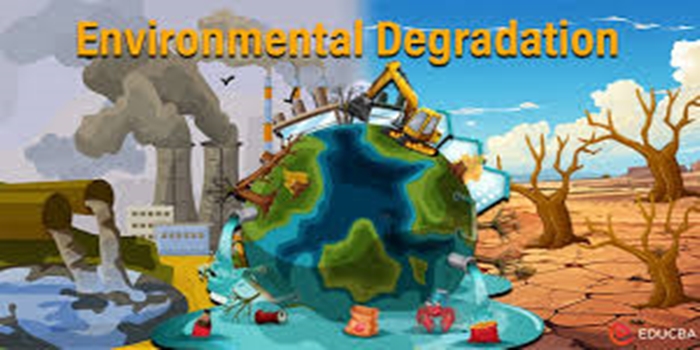In this article, we discussed the meaning of environmental degradation, the causes, the effects, we also talked about the solution
Definition
Environmental degradation is the process by which the environment deteriorates, reducing its health and biological diversity. It can be caused by natural events or human activities.
Environmental degradation is caused by human activities and natural events.
Human activities
Deforestation: The permanent removal of forests for other uses, such as fuel or commodity production. Deforestation can lead to soil erosion, droughts, floods, and climate change.
Pollution: The release of harmful chemicals, gases, and particulates into the air, water, and soil. Pollution can come from industrial processes, transportation, and burning fossil fuels.
Urbanization: The movement of people from rural areas to cities, which can lead to ecological challenges.
Industrialization: The expansion of industrial activity, which can contribute to pollution.
Agriculture: The intensification of agricultural practices, such as the use of fertilizers and pesticides, can lead to nutrient loss, soil erosion, and water contamination.
Transportation: The use of vehicles, which can contribute to air pollution.
Natural events
Floods: Can be a result of the water cycle being disrupted by deforestation.
Droughts: Can be a result of the water cycle being disrupted by deforestation.
Poverty
Poverty can be both a cause and an effect of environmental degradation. When people lack the essentials for survival, they may be more vulnerable to environmental degradation.
Environmental degradation can have many effects, including:
Pollution
Air pollution can harm human health and damage crops and trees. Water pollution can limit access to clean water and endanger human health.
Climate change
Pollution, especially from greenhouse gases, causes climate change. This can lead to global warming, more severe weather, rising sea levels, and ecosystem shifts.
Biodiversity loss
Human consumption, population growth, and urbanization have led to the use of more resources than the Earth can replenish. This has resulted in a loss of biodiversity.
Soil damage
Environmental degradation can damage soil by eroding it, increasing salinity, compacting it, and decreasing organic matter. This can make it harder for plants to grow.
Water scarcity
Agriculture uses a large amount of freshwater, but much of it is wasted. This can lead to water scarcity.
Economic impact
Economic growth can lead to ecosystem degradation. For example, mangrove forests may be converted into shrimp farms.
Disaster risk
Environmental degradation can increase the risk of disasters.
The Solution to Environmental Degradation
Reduce, reuse, and recycle: Reduce the amount of waste you create, reuse items when possible, and recycle what you can.
Use less energy: Conserve water and electricity, and turn off lights and electronics when you’re not using them.
Plant trees: Trees absorb carbon dioxide and other pollutants, and provide shade and shelter.
Use renewable energy: Use renewable energy sources like solar or wind power instead of fossil fuels.
Support sustainable practices: Support organic farming and sustainable waste management practices.
Reduce pollution: Reduce air pollution from vehicles and industrial activities, and reduce water pollution.
Conserve natural resources: Conserve water, electricity, and other natural resources.
Educate people: Raise awareness about environmental degradation and its consequences.
Advocate for policy change: Support policies that prioritize environmental conservation.
Collaborate internationally: Work with other countries to address global environmental issues.
Conclusion
Environmental degradation is the process by which the environment deteriorates, reducing its health and biological diversity. It can be caused by natural events or human activities.


